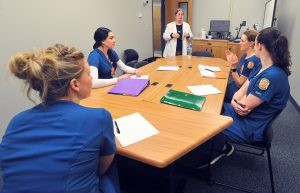Idaho Department of Labor Press Release
Doug Lindley/Idaho State Journal
Professor Elizabeth Damstrom instructs Idaho State University nursing students from left Alyson Bergeson, Danny Piranfar, Amber Walker and Megan Hochstein during their labs.
While Idaho institutions produce and license just enough nurses for a healthy labor market across the state as a whole, significant shortages in many surrounding states are attracting Idaho graduates, negatively impacting the supply in certain regions, according to a report issued this week by the Idaho Department of Labor.
Southwestern Idaho in particular faces a challenge to produce enough nurses to keep up with health care workforce demands as the population ages and continues to grow considerably faster than the state and national averages.
The Idaho Nursing Overview 2017: An Interim Report examines workforce supply and demand for licensed practical nurses (LPNs), registered nurses (RNs) and advance practice nurses (APRNs) in the state to help determine where shortages or surpluses may occur. Education capacity, wages and faculty issues are also reviewed.
Nursing continues to be a “hot job” in Idaho, with RNs ranking 11th according to Idaho Labor’s 2014-2024 long-term occupations projections, dropping from second in the 2012-2022 projections. The ranking is based on fastest growing, most abundant and highest paying occupations.
For the 2015-2016 academic year, the 11 Idaho institutions offering nursing degrees admitted 1,238 students, down from 1,331 admissions to 12 institutions for the 2013-2014 academic year as reported in the 2015 Idaho Nursing Review.
Wages in Idaho for LPNs and RNs ranked fifth of the surrounding states of Montana, Wyoming, Utah, Nevada, Oregon and Washington. Nurse practitioner wages in Idaho were the lowest of the seven states.
Idaho continues to have unfilled faculty positions, reporting 18 unfilled among all the nursing programs. Retirees and faculty returning to a practice setting will likely be difficult to replace. Faculty who educate practicing and future RNs must have a master’s degree to teach.
Because of a change in the self-reporting method for RNs in 2015 and 2016, some data was not collected, resulting in the interim report, which provides a nursing workforce status as a bridge between the more comprehensive 2015 Idaho Nursing Overview and the next comprehensive report in 2018, which will reflect the complete data.
This report was produced in collaboration with the Idaho Board of Nursing, Idaho Alliance of Leaders in Nursing, Boise State University, Brigham Young University – Idaho, Carrington College, College of Southern Idaho, College of Western Idaho, Eastern Idaho Technical College, Idaho State University, College of Technology and School of Nursing, ITT Technical, Lewis-Clark State College, North Idaho College and Northwest Nazarene University.
Find the full report at labor.idaho.gov/publications/NursingOverview2017.





